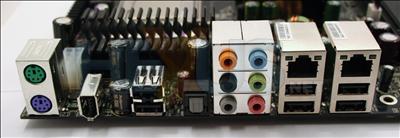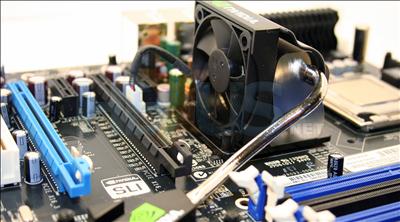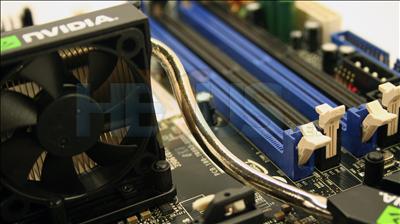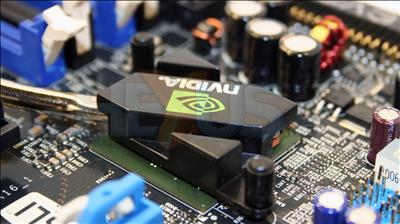Layout
The board has an almost perfect layout -- in this reviewer's eyes at least and as far as my own personal chassis layout goes -- NVIDIA putting the power connectors, floppy and IDE ports on outer board edges to start with. The CPU area uses low-profile components for optimal CPU area usage and the CPU fan header lies nearby.
The memory slots sit high enough on the board so as not to interfere with the graphics card, which is the same reasoning for the first 4 SATA ports being where they are. All too often you'll see SATA ports obscured by long graphics boards (and by Christ, 8800 GTX is long), so NVIDIA have chosen to move 4 of them up the board a bit but still keeping them near the right edge. It's a great port placement for me, but I grant it might not be incredibly awesome for thee.
The cooling is somewhat unique in that the fan is optional, users only needing it if their case doesn't have much in the way of airflow, or if they want to push the board hard in terms of overclocking. It's not very loud even at full speed, so it might be worth using even if you're not overclocking just to be on the safe side, but it is fiddly to attach, the fans screws requiring a very tiny screwdriver to operate properly.
The heatpipe works from south to north, heat from the low-profile MCP cooler travelling towards the larger heatsink mass for exchange to air. The pipe doesn't block graphics card install in the top PCIe x16 slot and there's nothing blocked by the fitment of a graphics board in the bottom PCIe x16 slot either, so with SLI and dual-slot graphics boards you still get both PCIe x1 slots and a PCIc slot, NVIDIA choosing expansion slot placement just for that purpose.
The front panel connectors are in an arguably poor position between memory slots, auxiliary Molex power (not needed to run the board) and IDE port, but that's the only real layout problem your author has. Notable board detailing includes POST code display, buttons for power and reset for using the board outside of a case (handy for reviewers like me) and sensible fan header placement. Power component cooling is done using styled, black aluminium heatsinks at the top of the board, the PCIe x16 slots use excellent little retention clips, and port headers are in reasonable positions.
In short, not perfect for all but very nearly perfect for some. I love the SATA port layout (4 high-up slots, 2 rotated out) because I run 6 disks in my PC in positions that suit that just nicely, a GeForce 8800 GTX which wouldn't block off any board features or ports, and since I run my IDE burners high up in my chassis, the IDE port being high-ish on the board is a boon (it's much further down on my current board causing the cable to be tight). Your mileage may very much vary, but if you own a chassis that does things ATX style (CPU at the top, PSU above it), you'll likely really enjoy the board layout of this thing.














